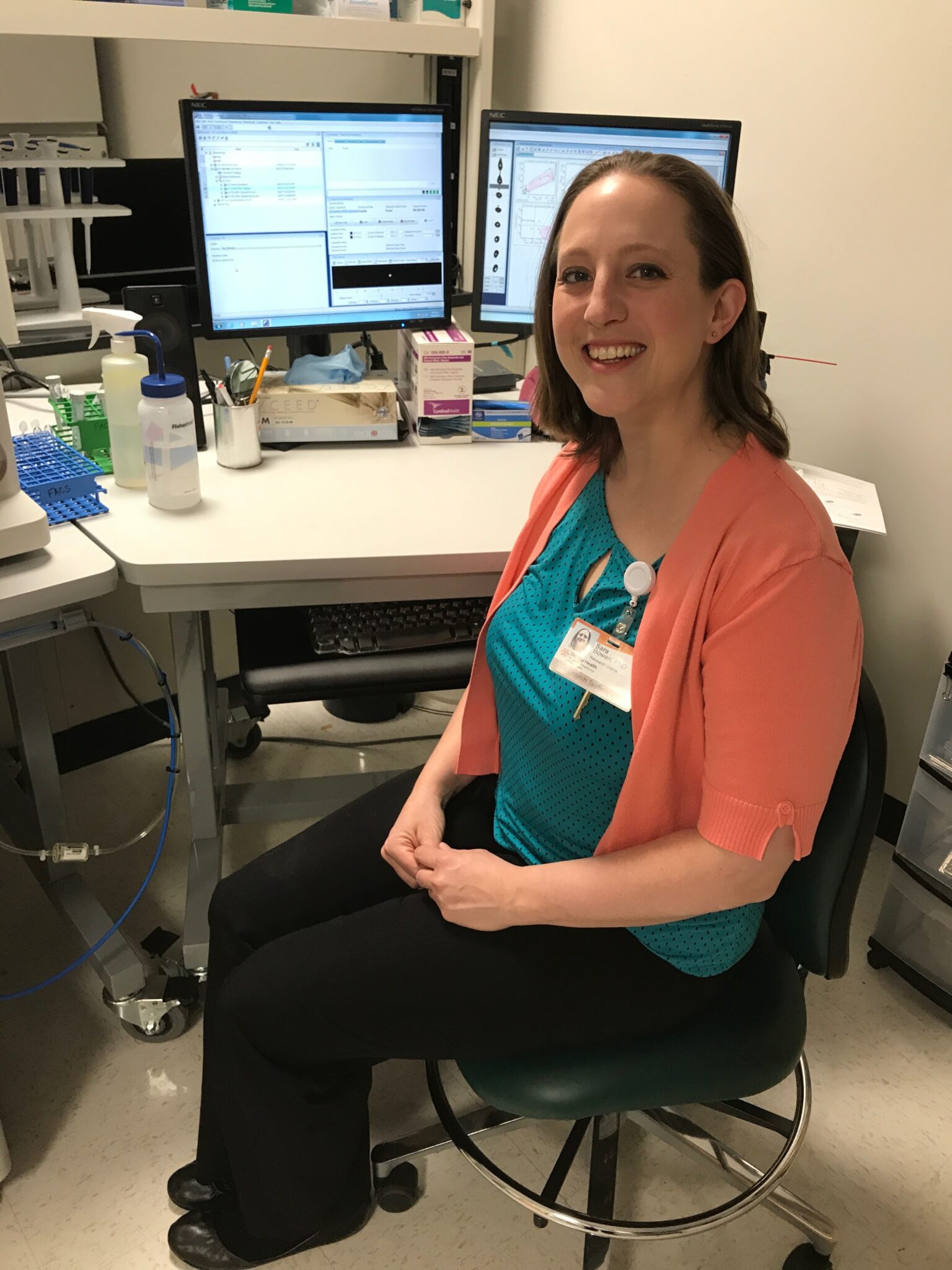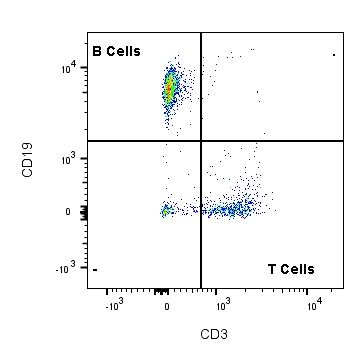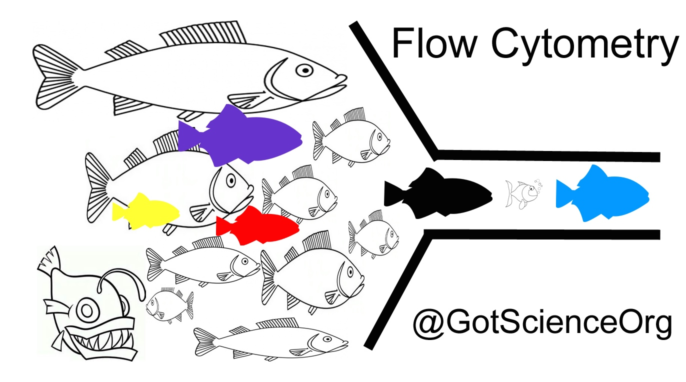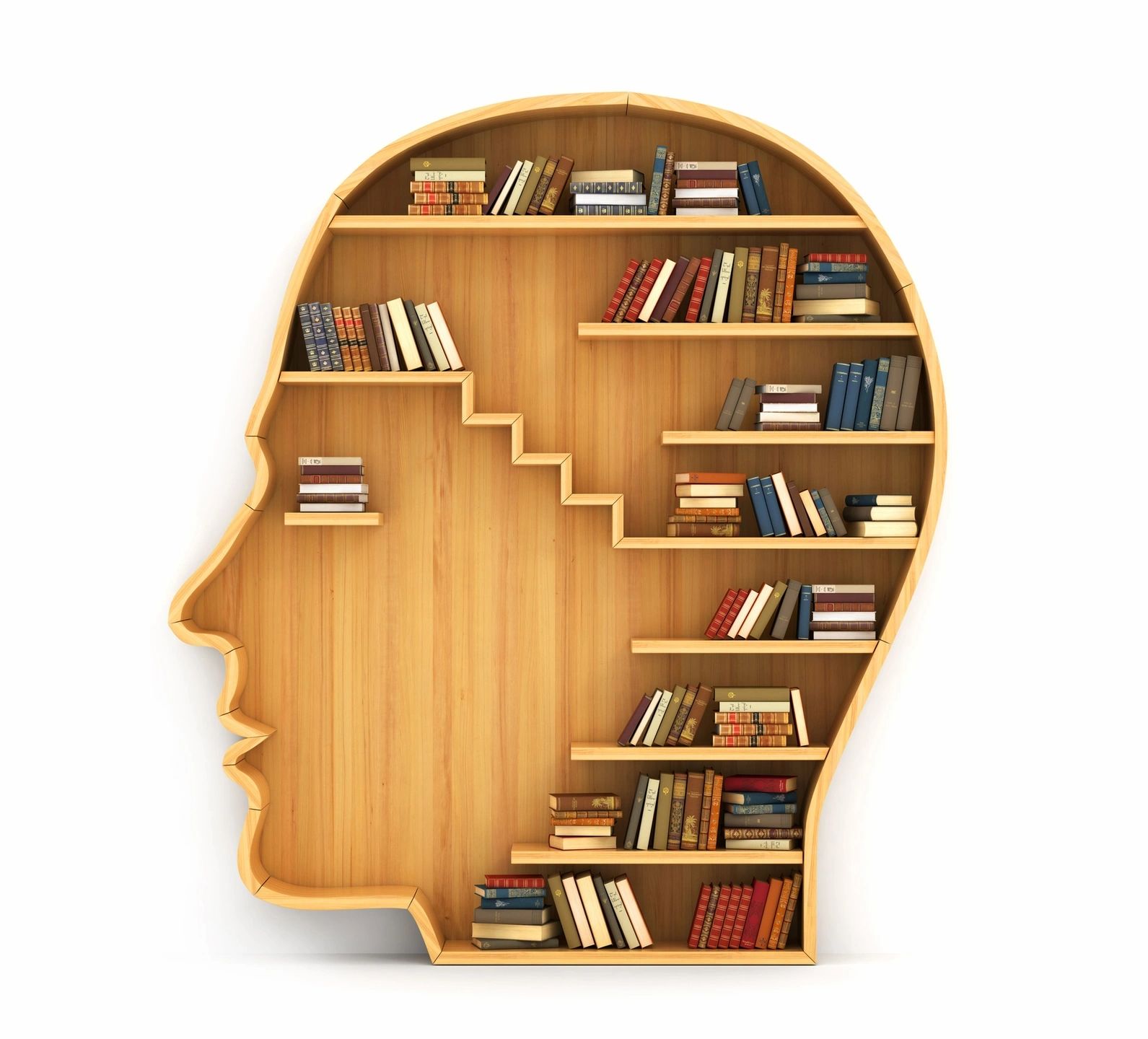By Cathy Seiler
Sara Bowen, PhD, is a biochemist with what can only be described as a giddy excitement for her job. She runs the flow cytometry facility at St. Joseph’s Hospital and Barrow Neurological Institute in Arizona, and she positively lights up when talking about “flow” and her lasers.

An analogy to understand flow cytometry is to think about a stream filled with lots of different fish: big fish and small fish, black fish and white fish. To better understand the characteristics of the fish in the stream, you could direct each fish into a small channel in the stream where they can pass through in single file. From looking at them one at a time, you can note if the fish is big or small or black or white. Flow cytometry is exactly like this. Instead of fish, Sara is looking at hundreds of thousands of cells. Instead of a stream and a small channel, she is using a flow cytometry machine. And instead of her eyes and a notebook, she’s using lasers and flow cytometry software. And yes, her job really is that cool.
We had a chance to talk with Sara about being a scientist, how she got interested in flow cytometry, why flow is so important, and why she’s so obsessed with lasers.
Cathy Seiler: You have your PhD in biochemistry, but not all biochemists do the same thing. What does being a biochemist mean to you?
Dr. Sara Bowen: When I think of biochemists, I sort us into two main buckets. Some are trying to understand parts of a picture. They are looking at a very specific piece of biology and trying to figure out how it does what it does. For example: How does the shape of a hemoglobin protein affect its ability to hold on to and release oxygen? Biochemists in the other bucket are asking questions about the picture as a whole. They want to know how the parts fit together to make biological processes work. For example, what hormones are released when you eat a tangelo, and how do they help you digest it? But zoomed in or zoomed out, all biochemists are trying to understand how biology works, be it human, penguin, jellyfish, or tulip tree biology.
Seiler: How did you first become interested in flow cytometry?

Bowen: Ever had to give a book report? Well, that doesn’t stop when you get to graduate school. I had to read a scientific paper about flow cytometry and explain it to my classmates, and at the time, I had never even heard of flow. When I was getting started, all I could think about was that the data looked like someone had sneezed on a page. How does anybody make sense of all those dots?! But in the process of learning about flow well enough to explain it to my classmates, I realized that it is a powerful tool for scientists. And when it hit me that the whole thing is possible because of all the colors in the rainbow, I was in love.
Seiler: What is with your obsession with lasers?
Bowen: Did I mention that I like colors? Each of my lasers is a specific color: violet, blue, or red. The cells (or molecules that are attached to the cells) that I’m looking at interact with different colors of light differently depending on the cells’ or molecules’ physical properties. That sounds complicated, so think of it this way. Your boss comes in and says, “What is going on in here?” Depending on the tone of voice, you will probably react differently. If your boss sounds angry, you might react defensively. If your boss is laughing, you might laugh back. If your boss is clearly talking to himself as he or she wanders by, you might not react at all. A big part of my job is figuring out how to combine laser color and cells or molecules so that I can gauge the “reactions” of the cells or molecules in a way that I can understand. My job is a game, and lasers make it possible to play.
[Cathy’s note: If you think of the fish analogy above, the lasers are what detect the color of the fish in the stream.]
Also, just say out loud: “I work with lasers.” Sounds impressive, right?
Seiler: How can flow cytometry and your work help people?
Bowen: I think a good way to start answering this question is by listing some of the things flow cytometry has already done for people:
- It was crucial for understanding and diagnosing HIV/AIDS.
- It was instrumental during the Human Genome Program.
- It has been critical in understanding, diagnosing, and treating leukemia and lymphoma.
All three of those contributions are massively important to humankind. In my work, I’m helping other scientists use flow to combat serious health issues including stroke, Multiple Sclerosis, brain cancer, and transplant rejection.
RELATED: USING FLOW CYTOMETRY IN BIOMEDICAL SCIENCE
Seiler: What is one thing you really want readers to know about you, flow cytometry, or science in general?
Bowen: Scientists are just regular people. Most of us aren’t particularly brilliant, but we are persistent. We’re all trying to understand things that have never been explained before. We do that by building on what’s already known and testing all the possibilities that might add knowledge. That means most days science is more tedious than exciting.
Seiler: What advice would you give to someone who is interested in pursuing a career like yours?
Bowen: Be persistent. Sometimes (or a lot of times) you will fail, and that’s OK. It might feel like you are the only one struggling, but I promise you’re not.
—Dr. Cathy Seiler is the manager of the Biobank Core Facility at Barrow Neurological Institute and St. Joseph’s Hospital. She received her bachelor’s degree in biochemistry and molecular biology at Boston University and her PhD at the Watson School of Biological Sciences at Cold Spring Harbor Laboratory, studying cancer. In her spare time, Cathy is the editor for ISBER News and writes about science and the life of a scientist on her blog Things I Tell My Mom.




